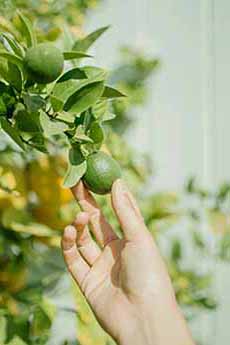The Parts Of A Lemon For National Lemon Juice Day
|
|
August 29th is National Lemon Juice Day. Let’s give the lemon some respect: It doesn’t even have its own holiday. Just the juice does. So it’s time to discover what’s under the peel besides pulp and juice. A number of different things to do with the juice itself is below. > The history of the lemon. The lemon is a member of the Citrus genus of flowering trees and shrubs, in the Rutaceae family. In addition to lemons, members of the Citrus genus include familiar citrus fruits such as citrons, grapefruits, kumquats, limes, mandarins, oranges, and pomelos, as well as less-familiar citrus fruits such as Buddha’s hand, finger limes, and kaffir limes. The Citrus genus is native to South Asia, East Asia, Southeast Asia, Melanesia, and Australia. Lemons are thought to have originated in northwestern India. Here’s how a botanist looks at a lemon (photo #2). Instead of presenting the parts in alphabetical order, we’ll start at the rind and work our way inside. Ranging from green to bright yellow in color depending on the level of ripeness, the flavedo contains essential oil glands that provide the lemon’s aroma. The flavedo is an important source of vitamin C, polymethoxyflavones and carotenoids—both cancer-fighting flavenoid antioxidants. Immediately under the flavedo (rind) is the white, spongy inner layer of the lemon. It’s the most important source of pectin and carbohydrates. The albedo is also an important source of phenolics and flavanones, both antioxidants. The endocarp, or pulp, is the edible part* of the lemon rind, representing between 65% and 70% of the lemon’s weight. It’s pale yellow in color and is divided into segments that contain elongated cells—known as the juice sacs or vesicles—where water, carbohydrates, and citric acid accumulate. Each slice of lemon contains hundreds of juice sacs, and there may be one or more seeds. In the aggregate, the juice sacs make up the pulp. The columela is the central axis that connects the membranes that form between the sections of the endocarp. The membranes separate the fruit segments and help to hold the pieces of pulp together. The texture is thin and papery; depending on the variety, it can be thinner or thicker. A hesperidium (plural hesperidia) is a fruit with sectioned pulp inside a separable rind, e.g. in a lemon, orange, grapefruit, or another citrus. Carl Linnaeus (1707 to 1778, also known as Carl von Linné), “the father of modern taxonomy,” was the great Swedish botanist, zoologist, taxonomist, and physician who formalized binomial nomenclature, the modern system of naming organisms. He gave the name Hesperideae to the order containing the genus Citrus, in allusion to the golden apples of the Hesperides†. [source] Now that you have a botanist’s perspective on lemons, here are uses for lemon juice. After all, it’s National Lemon Juice Day! ________________ •The flavedo, or peel, is also eaten: as grated zest, as cocktail garnishes, and cut into strips and turned into candied peel, which is enjoyed as a garnish or as a confection, eaten plain or dipped in chocolate. †The Golden Apples in the Garden of Hesperides were a wedding gift to Hera from Gaia and were protected by a great serpent called Ladon. The Apples as well as the rest of the life in the Garden were tended by the Hesperides, minor earth goddesses or nymphs and daughters of the Titan, Atlas. Herakles (Heracles) was sent to fetch the golden apples of the Hesperides as one of his twelve labors. |
|
|
|
||



